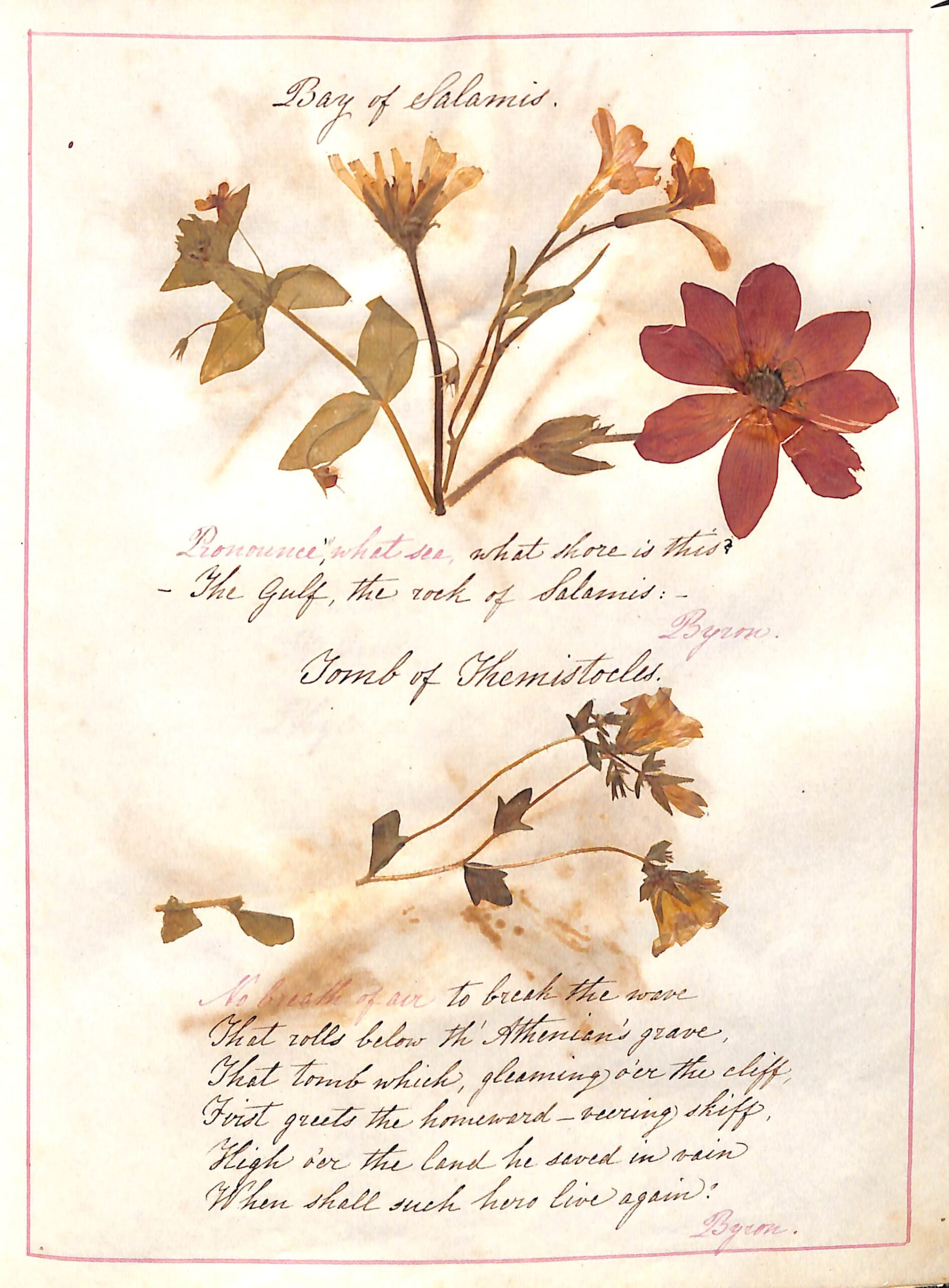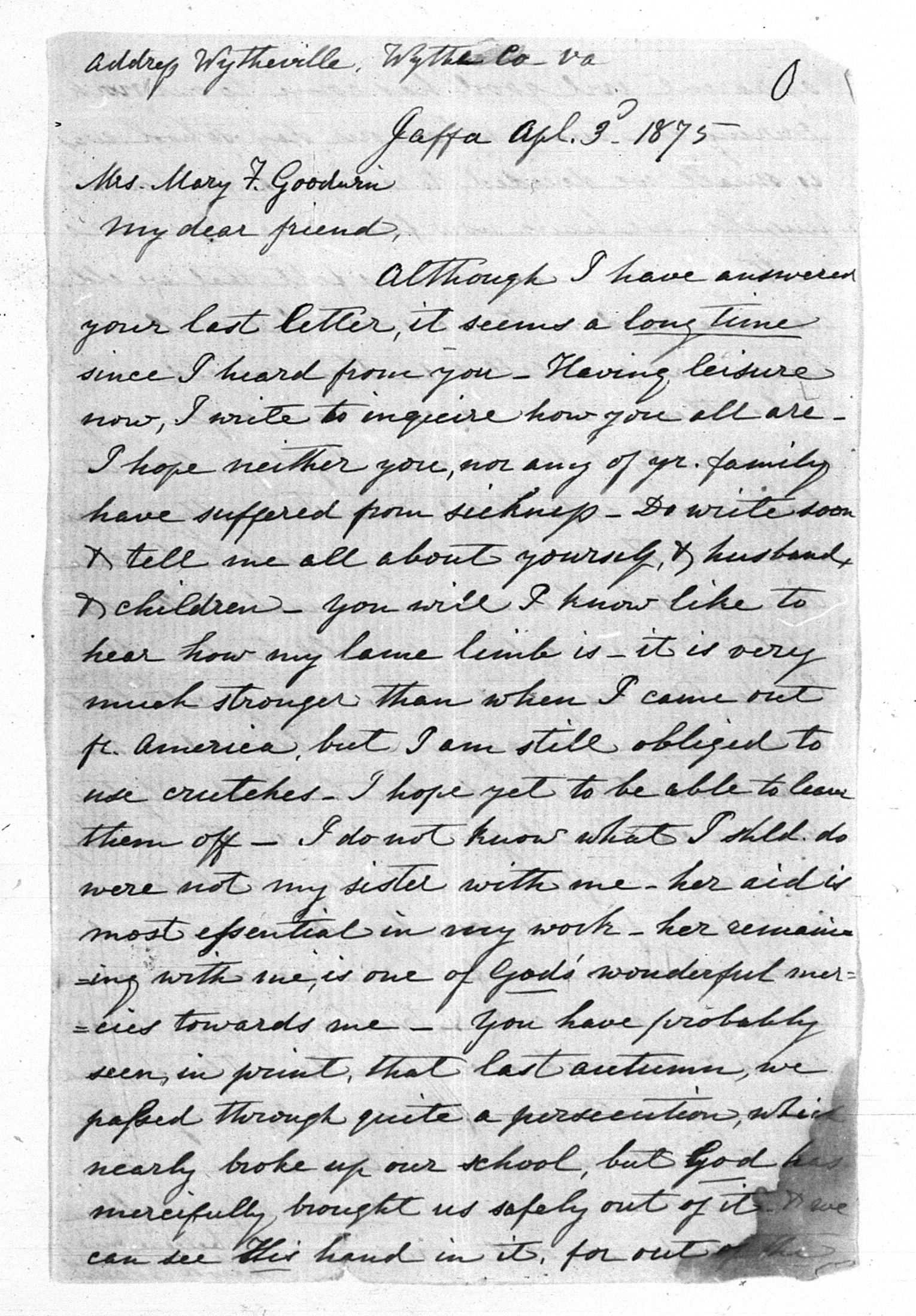
Be your own botanist.
Audience
Ages 5+
Background
Mary collected plants in her new home of Athens, Greece, pressed them into an herbarium book, and sent them to her grandmother, Ann Tunstall Maury Hite. In this herbarium from 1850, Mary pressed various plants, herbs, and flowers from places in and around Athens and placed them in between passages from the Bible.
Objective
Learn about different plant species, including a plant description, plant parts, date and place collected, common and scientific plant names, and so forth
Activity
- Collect plants, making sure to cut at the base of the stem.
- Place the plant in a baggie or basket.
- Dry each plant by placing it between parchment paper and weighing it down with something heavy like a book.
- Wait a few days to allow enough time for the plant to properly dry.
- Once the plants are fully dried, carefully attach them to sheets of paper using glue or tape.
Note: Only place one plant per page to allow enough space to take notes. - Include the following notes on for each plant:
- Plant’s common name, botanical name, or both
- Date and location where you collected the plant
- If and how you may use the plant
- What made you collect the plant – i.e., the way it smells, the way it looks, its color, or anything else that makes you curious
- Any other observations that you want to document
- Slide each page in a plastic sleeve, such as this one, and place it in a binder.

Explore 19th century American tourism to the Holy Land.
Exhibit: Dreamland: American Travelers to the Holy Land in the 19th Century
Source: The Shapell Manuscript Foundation
Audience
11th Grade U.S. History or 12th grade U.S. Government
Background
Direct quote taken from the Shapell Manuscript Foundation’s website: “The idea of the Holy Land, roughly the area between the Jordan River and the Mediterranean Sea, loomed large in the imagination of many 19th century Americans. Most Americans were avid readers of the Bible at this time and were well aware of locations such as Jerusalem, the Sea of Galilee, Bethlehem, and Golgotha. With the arrival of the industrial revolution and especially the invention of steam-powered ships, travel to these locations finally became possible for many Americans. Companies emerged to plan trips for eager tourists, but when they arrived the reality often did not match their expectations. Ottoman Palestine was different from the United States in many ways and very different from the holy land Americans had long imagined.”
Objective
Learn about American tourism to the Holy Land, including means of travel and the draw to visit
Activity
Follow the activities outlined in this lesson plan.
For additional information, see the American Tourists in the Holy Land, 1865-1900 teacher resource on the Shapell Manuscript Foundation’s website.

Transcribe historical handwriting.
Audience
Ages 16+
Background
Mary was an avid letter writer, and we are fortunate to have 30 pages of these handwritten letters that we obtained from the Digital Production Group at the University of Virginia Library. In this activity, you will engage with these letters, learning how to read and transcribe historical handwriting.
Objective
To engage with primary sources and increase access to these historical records so that they may be read and used by a broader audience
Activity
- Navigate to the Letter Transcription page.
Note: On this page, the digital letter is listed in the left column and the link to a Google Word document is listed in the right column. - Once you have selected the letter that you would like to transcribe, click the link to open the Google Word document.
Note: This link will open in a new tab. - Zoom in on the letter by hovering your mouse over the digital letter, which will bring up a box that magnifies the text and moves with your mouse.
- Toggle – or go between – the Google Word document and the digital letter as you transcribe Mary’s original handwriting.
Note: It may be help to have the two windows open and side-by-side. - Once you are done transcribing, save and close the Google Word document.
- Optional: Feel free to leave questions and comments at the bottom of the Letter Transcription page.